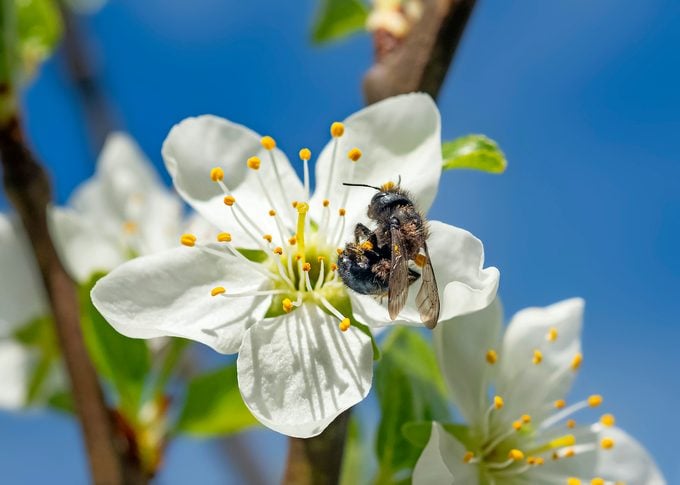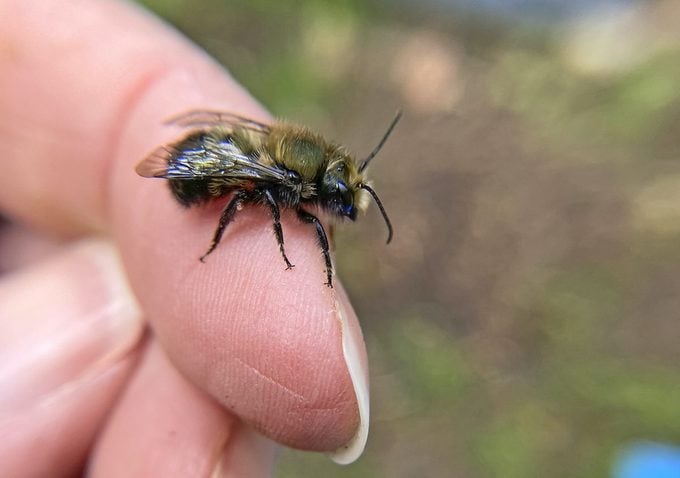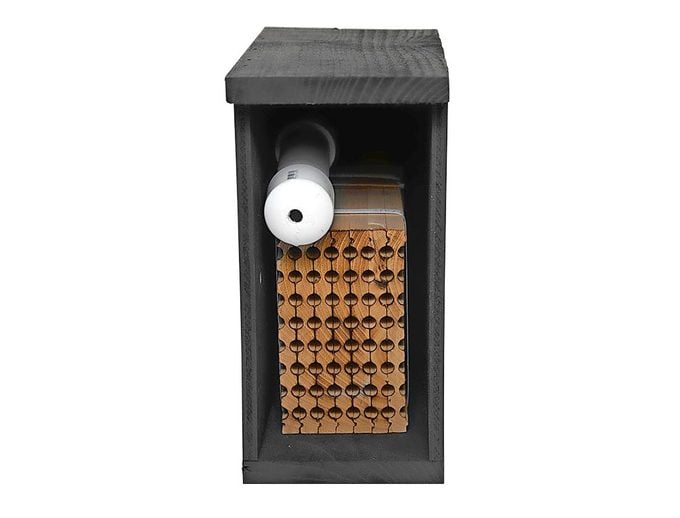How to Attract and Host Mason Bees in a Bee House
Updated: Nov. 02, 2023
Mason bees are very helpful to your garden, and it's easy to attract them to your yard with a bee house. Here's what you should know.
What Are Mason Bees?

You’ve almost certainly heard of honeybees, but what about mason bees? These docile fliers are extremely helpful in your garden, and there’s an easy way to invite them into your backyard: a bee house. Here’s everything you need to know about mason bees.
Discover fascinating bumblebee facts you should know.
Mason Bees vs Honeybees
There are more than 150 species in the mason bee group, which handled pollination here long before European honeybees arrived. Unlike honeybees that gather pollen in packages on their hind legs, mason bees collect pollen in a rather amusing fashion: They belly-flop into blossoms, and the pollen clings to the hairs on their bodies. According to Thyra McKelvie of Rent Mason Bees in Bothell, Washington, they can pollinate up to 2,000 flowers per day, and each one can do the work of 100 honeybees. Impressive!
Because they’re well-adapted to the climate here, they fly in cooler temperatures and brave drizzly conditions.
Meet more beneficial bees you want in your garden.
Do Mason Bees Sting?

The busy fliers are valuable in home gardens because they pollinate an array of early-blooming plants. Plus, they’re easy to raise and fun to watch. Renowned for their gentle disposition, they are suitable for families with children and are not aggressive even in close proximity. Male mason bees do not sting. And about the only way to incite a defensive sting from a female is to squeeze or step on her.
The reason for their non-aggression? They don’t have hives, so there is nothing for them to defend. Instead of using honeycomb cells, they lay their eggs in existing gaps or tunnels. A female creates a mud plug on one end, adds a loaf of pollen and nectar, then lays an egg. The next layer follows the same pattern until the tunnel is packed with eggs and sealed with more mud. Hence the name “mason” bee.
“Their life cycle is similar to a butterfly,” Thyra says. While a honeybee queen lays 1,500 to 2,000 eggs per day, a female mason bee produces only 15 in her four-to-six-week lifetime.
Discover 6 key differences between bees and wasps.
Mason Bee Cocoon
Once the eggs hatch, each larva consumes its pollen loaf and spins a silken, hardened cocoon to overwinter in. Young mason bees emerge when conditions warm in spring. The males (noted by the white tuft of fuzz on their heads) appear first, with females appearing soon after.
Discover 8 bugs you should never kill in your garden.
How Do I Attract Mason Bees to My Yard?
Creating an ideal environment for these bees is critical. According to Matthew Shepherd, director of outreach and education for the Xerces Society for Invertebrate Conservation, planting native flowers is a must—and of course, avoid using pesticides in your garden. To help mason bees nest, he says you can provide nesting sites. To do this, allow a certain level of imperfection in your yard and garden. For example, they may use chambers in dead trees where birds have pecked holes to find insects.
Psst—we found the best flowers that attract bees.
Mason Bee House

For a more direct way to add them to your backyard, you temporarily host them by ordering a bee house from Rent Mason Bees. It’s simple! You order a kit (which includes bees) to arrive in early spring. When the bees are done pollinating your yard, mail back the nesting block. Rent Mason Bees harvests, cleans and protects the cocoons over the winter and then provides bees to farmers and gardeners, who release them into their crops. Here’s why we love beeswax wrap as a natural alternative to plastic wrap.
Next, learn 6 easy ways how you can help bees.
